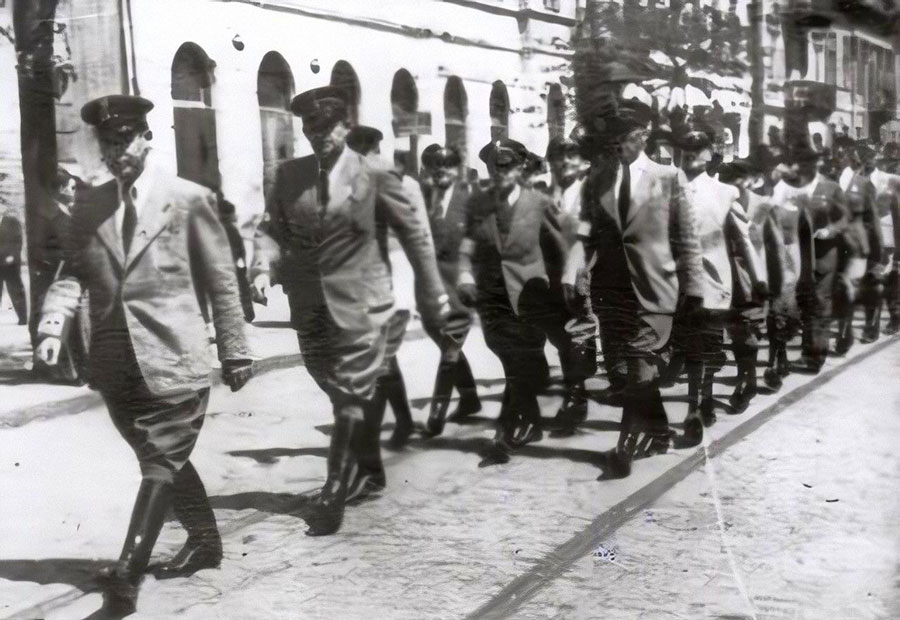Group 13
The Group Thirteen network was a Jewish Nazi collaborationist organisation in the Warsaw Ghetto during the German occupation of Poland in World War II. The Thirteen took its informal name from the address of its main office at 13 Leszno Street in Warsaw. The group was founded in December 1940 and led by Abraham Gancwajch. Sanctioned by SD (Sicherheitsdienst; SS Security Service – an intelligence agency), and also known as the Jewish Gestapo, the unit reported directly to the German Gestapo office.

The group vied for control of the ghetto with the Judenrat, and infiltrated the Jewish opposition within the ghetto. The group’s most important branch was the Office to Combat Usury and Profiteering in the Jewish Quarter of Warsaw. Supposed to fight the black market, it actually collected large sums via racketeering, blackmail and extortions. The group also ran its own prison. In total, the group numbered between 300 and 400 uniformed Jewish officers, distinguished by caps with green bands. The admittance payment to become a member of the “13” was several thousand zlotys issued by the German-controlled Bank.
Stanisław AdlerBarrister, Jewish Police (Order Service) officer. Resigned from his post, when the Germans started the deportation, his decision was accepted by the the Judenrat - he then became head of the Housing Office. In 1942 he lived in the area of big ghetto. He was privileged to move in-between the ghettos. He is a supporter of armed resistance. Escapes from the ghetto, hides in Saska Kepa, later in Anin. In July 1946 he becomes a honorary member of the law faculty in Warsaw University. After the Kielce pogrom he commits suicide. Autor of "In the Warsaw Ghetto 1940-1943 An Account of a Witness. The Memoirs of Stanisław Adler". wrote about "recruiting" to the Group 13:
The fee for membership of "Trzynastka" was several thousand zlotys. It was a lot of money back then. At one point, when Gancwajch was in need of money, he began to increase the number of his staff members every day, which provided him with a considerable sum of money. Most of this money was intended for bribes to the Germans to protect "Thirteen" from the threat of ending its existence. No special formalities or controls were used when recruiting candidates for the Thirteen, so it is not surprising that elements from the criminal world have become an overwhelming part of this organization. The fact that most of these men became future Jewish Gestapo men showed who patronized the "Thirteen" and the majority of the Jewish population in the ghetto, viewed this organization with suspicion and fear. He was also responsible for the administration of around one hundred Jewish houses in Leszno Street.

In July 1941 the Group 13 lost to the Judenrat in the political arena and the Office was incorporated into the Jewish Ghetto Police force.
After the Office was closed, the active members of the Group 13 centered on Gancwajch, and concentrated their efforts on setting up their own infirmary and ambulance service (the so-called Emergency Service, or the First Aid Station, which was created in May 1941). However, the company’s resources soon became used predominantly for smuggling and contraband. They also ran other operations, for example a brothel at the Britannica hotel. They had near total control over the horse-drawn carriages and all transportation within the ghetto.

Shortly before the Office was closed, there was a split in the Group leadership, when Morris Kohn and Zelig Heller broke with Gancwajch and established their own organizations. Kohn and Heller eventually outlasted the Group. Their demise only came during the mass deportations of Jews from the Warsaw ghetto to the German Treblinka extermination camp by Germans in the course of Grossaktion Warsaw (deportation and mass murder of Jews from the Warsaw Ghetto).
In 1942 many members of the Group 13 were executed by Germans in Operation Reinhard (plan to exterminate Polish Jews in the General Government district of German-occupied Poland) during which Germans killed around 2 million Polish Jews. Gancwajch and surviving members of the group later re-emerged posing as Jewish underground fighters, though in reality they were hunting for Poles hiding or otherwise supporting the Jews. After closing the Jewish Gestapo, Gancwajch stayed in Warsaw outside the ghetto, where he continued working for the Nazis. He was rumored to have died around 1943; a hypothesis about his post-war collaboration with the NKVD was never confirmed.





